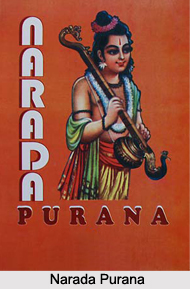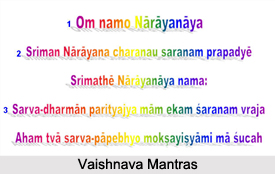 In the Narada Purana the word `mantra` is associated with the combination of the two words `manana` meaning Sarva-veditva (knowing every thing) and `tra` meaning `Sarva-anugraha` (blessing one by giving him liberation from the world). Male, female and neuter, are the three divisions into which mantra have been divided. Another classification is that the mantras with `Om `R` at end and Svaha` are known as Agneya` (related to fire), and that with Bhrgubija (Sam) and `Piyusabija` (Varh) as `saumya` (related to Soma, the Moon). The female deities lead the vidyas and the male gods lead the mantras. Mantras should be chanted with invocation and the deity fulfils the wishes. Recitation is to be done without pause of breath and its control.
In the Narada Purana the word `mantra` is associated with the combination of the two words `manana` meaning Sarva-veditva (knowing every thing) and `tra` meaning `Sarva-anugraha` (blessing one by giving him liberation from the world). Male, female and neuter, are the three divisions into which mantra have been divided. Another classification is that the mantras with `Om `R` at end and Svaha` are known as Agneya` (related to fire), and that with Bhrgubija (Sam) and `Piyusabija` (Varh) as `saumya` (related to Soma, the Moon). The female deities lead the vidyas and the male gods lead the mantras. Mantras should be chanted with invocation and the deity fulfils the wishes. Recitation is to be done without pause of breath and its control.
If the mantra has awakening capability, the deity will produce Siddhi and if intoned with garland even the faulty one will become Siddha. Narada has given an explanation and characteristics of the defective mantras. Imperfect mantras become perfect when they are recited by one seated in yonimudrasana, a yogic posture.
Initiation into Mantras
One who teaches the mantras and one who is gaining knowledge need to have certain traits. Having the family tradition in teaching, he who is practicing the chanting of mantras daily, is obedient to his teacher, calm, self-controlled. He has the capacity to understand the principles of mantras, and giving punishment as well as blessing. He can speak well, possess a submissive nature, is competent and wise. These qualities are intrinsic in a teacher.
The student should be calm, obedient, pure at heart, self-controlled, attentive, set ideas and practices, and inclined to serve the teacher.
Principle and Procedure of Testing a Mantra
Certain principles and methods need to be followed before initiating a student into a mantra, the student as well as the mantra should be properly tested. In examining a mantra, the procedure is as follows:
A square has to be drawn and divided into sixteen equal squares. The first letter of the alphabet, i.e., `A`, in the first square, second in the second, third in the third and the fourth in the fourth square has to written respectively. Thereafter continue the writing of the rest of the letters in the same order till all letters are utilized. The counting of the squares should be pradaksina (clockwise) starting with the square in which the first letter of the name of the student appears. If both come in the first square of the first row, then the mantra is known as Siddha (accomplished). When it is in the squares of the second row then the mantra is known as Sadhya (fit for accomplishment) in the squares of the third row it is Susiddha (fully accomplished), and if it be in the squares of the fourth row, it is Ari (enemy). If the first letters of both come in the first, second, third and the fourth squares of the first row, then the mantra is known as Siddha-Siddha, Siddha-Sadhya, Siddha-Susiddha and Siddhari respectively. Then if they come in the four squares of the second row, it is Sadhya-Siddha, Sadhya-Sadhya, Sadhya-Susiddha and SadhySri respectively. If they come in the four squares of the third row, it is Susiddha-Siddha, Susiddha-Sadhya, Susiddha-Susiddha and Susiddhari, respectively, and if they be in those of the fourth row, it is Ari-Siddha, Ari-Sadhya, Ari Susiddha and Ari-Ari respectively.
 There are various other methods of testing a mantra, but the method described above is the most accepted one. The student reveres the teacher`s wooden sandals and honours the teacher by offering him clothes
There are various other methods of testing a mantra, but the method described above is the most accepted one. The student reveres the teacher`s wooden sandals and honours the teacher by offering him clothes
The teacher enters the sacrificial pandal, wards of all evils and prepares a mystical diagram used to summon a deity. Worshipping sphere of fire and its `Kalas` (digits), he performs sacrifice to the `Suryakalas (digits of the Sun), placing a pot before himself. He chants the mantras (the principal mantra of the deity worshipped) of and fills the pot with water, adores the `Candrakalas` "(digits of the Moon) in the same pot. He covers the pot with two garments and puts in it some herbs and nine precious stones. He places the five sprouts of Panasa (Jack tree), Amra (Mango), Aivattha (holy fig tree), Vata (Ficus bengalensis) and Bakula (Mimusops elengi), on the pot and sanctifies his deity.
The student occupies the altar and the teacher sprays water on him. He then keeps the sprouts on the student`s head, chanting the mantras in his mind, and again sprinkles water on him. Then the student performs acamana (sipping of water) with the remaining water and wears a new cloth. He salutes the teacher and takes seat in front of him. The teacher places his hands on the student`s head and repeats the mantra eight times in the ears of the student. Then the student pays respects to the teacher and offers daksina, (gift) to him.
Philosophical Idea of Mantras
The `mulavidya` (knowledge of the supreme spirit) should be meditated upon starting from Muladhara (the lowest Chakra) to Brahmarandhra (the aperture in the crown of the head). One should bring out the air and fire from its respective sources, and should meditate on Kundalini, which lies dormant coiled like a snake on Shivalinga in the Muladhara. One should awake it and, piercing the six chakras and should bring it up to the Brahmarandhra through Susumna and immerse it in the nectar there. Then he should concentrate on Parama Atman (the Supreme Spirit of Brahman) as encircled by the Jyoti (light) of Kundalini. The Kundalini is then brought back to its place, Muladhara. This is followed by the meditation and worship of his deity. While completing the performance, he should chant the Ajapa-mantra; the (Harhsa-Gayatri).Then he should perform mystical dedication of body.
The Narada Purana provides a classification of the mantras based on different deities. Narada mentions that among all the mantras, the Vaisnavamantras are the best and in the group of Vaishnava mantras, the Ram mantras.
Mantras are performed to invoke deities. Each mantra has its own spiritual and mystic quality. Chanting of mantras requires necessary training. It reiterates that attaining salvation is the ultimate goal.




















